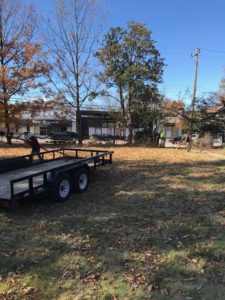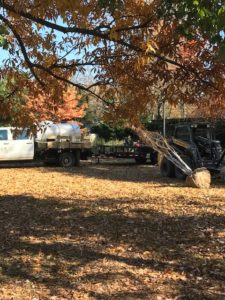Volunteer Tree Planting Day – December 15th 1pm – VHCA Parks Committee and Board Update on North Highland Park
Now that several past multiple Board’s have successfully retired the mortgage debt on the neighborhood-owned North Highland Park at St. Charles Place and North Highland Avenue (the two old library lots), it’s time to do some refreshing.
For an update, the Virginia-Highland Civic Association—as part of a multi-phase project, will be contracting to perform several long overdue efforts in the park: this work will include, tree pruning, removal of invasive and voluntary trees [(Mulberry and a 7” DDH (Dead, Dying, Diseased or Hazardous) Pecan)], weeding, new perennial plantings, volunteer plantings of several new trees and efforts to encourage preservation of the great stock of native trees that we have at the park—which is open to the public for use and events. Permits have been obtained for tree removal and the Pecan was destroyed due to utility pruning, unfortunately.
The VHCA Board allocated $10,000 of a generous $55,000 grant received from outgoing District 6 Councilmember Alex Wan last year toward efforts to help maintain and improve this park.
All work has been reviewed and approved by Peter Frawley, landscape designer, who originally designed the landscaping in the park.
The first phase—the tree pruning work, which totals $3,875, will raise the canopy on all existing large shade trees to 8’-10’ for better visibility/security and for best tree health, raise the canopy to 2’-3’ on the Bald Cypress trees in the rear of the park, include removal of a 3” Cherry Laurel, another Mulberry and the aforementioned DDH Pecan, prune all bushes behind the granite wall at the SW corner of the park to a height that is similar to the granite wall (leaving the camellias in front at height with the historic pillars), grinding of stumps and spreading of that mulch, and some general further pruning of additional Cherry Laurels, Ligustrum, etc.
Initial work performed on 12/4. (pics below)


VHCA, with the help of neighbor and Association member Stephanie Coffin, were also able to get Georgia Power to remove a large, invasive Mulberry last week at the NW corner of the park…free of charge as it sat under their utility lines.
Next, are plans for more improvements…first up is invasive and weed removal and a volunteer effort to plant several Serviceberry trees at the NW side of the park. Please mark your calendars to join us at the park at 1pm on December 15th for a volunteer work day to plant the three new Serviceberry’s. This is a great opportunity to contribute to the neighborhood—and, kids are more than welcome to join in.
After this work is done, we will look at more lighting and some ‘neighborhood-use’-focused enhancements.
If people have thoughts on good, additional uses for the park (please keep in mind it is under a perpetual, ‘eco-friendly’ covenant), please forward to ‘parks@vahi.org’.
Information below on why you raise the tree canopy provided by ISA-certified arborist Stephanie Coffin:
As limbs get larger, they are pulled down by gravity. Since it is not desirable to have large limbs dragging to the ground, the usual practice is to slowly raise the canopy. If the limbs are cut when they are fairly small in diameter, they will not leave much opening for the tree to close. Since trees don’t heal, their defense against virus, bacteria and insects is to “wall off” any opening in the bark. If limbs get large, the area that the tree has to protect is also larger. If the limbs become too big and are cut, the tree may be permanently damaged or will be open to attack.
Trees have to use energy to protect against injury. Making the right kind of cuts (in terms of size, exact spot to be cut, and, as small as possible) will help the tree recover. Any cut or mechanical wound must be sealed off by the tree. If branches are not cut outside the main trunk, the trees have to wall off part of the trunk to protect itself. This is also true if the cut leaves a stub and the tree has to heal off all the way to the trunk.
Canopy raising is done gradually to avoid damage to the tree. Another term is “limbing up.” We are going to raise the canopy to an eventual height of 10 feet for most of the trees. The Bald Cypresses will not be raised to 10 feet because this would take too much vegetation off at one time. The Atlanta Tree Protection Ordinance restricts pruning to no more than 20% of the live crown, so this gradual raising of the canopy follows the ordinance as well as aboricultural standards.
Of course the other reason is to keep the park open, so people can see inside the park from the sidewalk and also from across the street. This is done for safety reasons as well as inviting people to view the park with their eyes without stepping inside it.
Article contributed by David Brandenberger, President, VHCA and Chair, VHCA Parks Committee